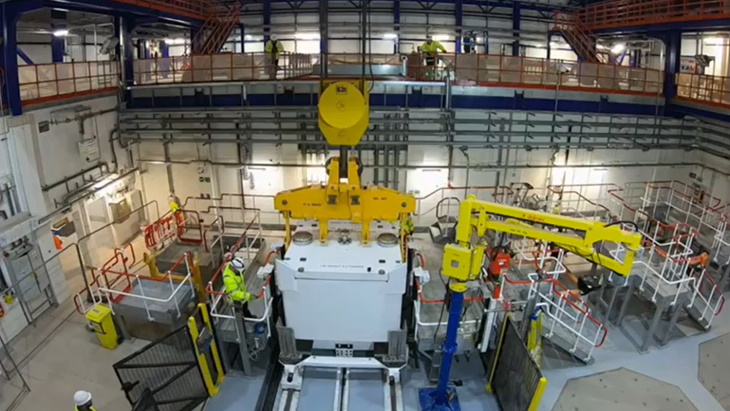The Box Encapsulation Plant Product Store - Direct Import Facility (BEPPS-DIF), which will take on and store waste from the Pile Fuel Cladding Silo at the Sellafield site in the UK, has successfully completed its first dry run of a storage box being transferred from road to its long-term storage vault.

The test waste box being lowered into BEPPS-DIF (Image: Sellafield Ltd)
Sellafield Ltd said it is the Direct Import Facility part of the operation that will bring tens of thousands of 3-cubic-metre steel boxes full of waste safely and securely into the storage vaults.
"This high-tech facility is the vital bit between the waste coming out of the Pile Fuel Cladding Silo and being stored in one of four product stores," it said.
There are two routes into the storage facility - one directly from the Box Encapsulation Plant and the other by road directly into the Direct Import Facility. "It's this vital road link which has been successfully tested," Sellafield Ltd noted.
"The test is to prove the Direct Import Facility and vault equipment will operate as one, to provide confidence ahead of our full plant performance demonstration," said project head Jeff Gaines. "This testing was a 'dummy run', undertaking the first full cycle of a package from the road bay to the vault.
"It was a complete success with no faults or failures. In addition, the project team welcomed our operators who were able to validate their instructions whilst getting some hands-on training on the equipment ahead of handover of the Direct Import Facility area to operations in March.
Real waste is currently expected to start coming through the facility this summer.
Built between 1950 and 1951 the Pile Fuel Cladding Silo (PFCS) is 21 metres high, subdivided internally into six individual compartments. It contains irradiated cladding materials removed from fuel assemblies used in some of the UK's earliest reactors at Windscale and Chapelcross and holds over 3200 cubic metres of intermediate-level waste. The PFCS was originally designed to remain sealed forever, but equipment has now been installed to enable the safe removal of the wastes so the facility can be decommissioned.
Researched and written by World Nuclear News